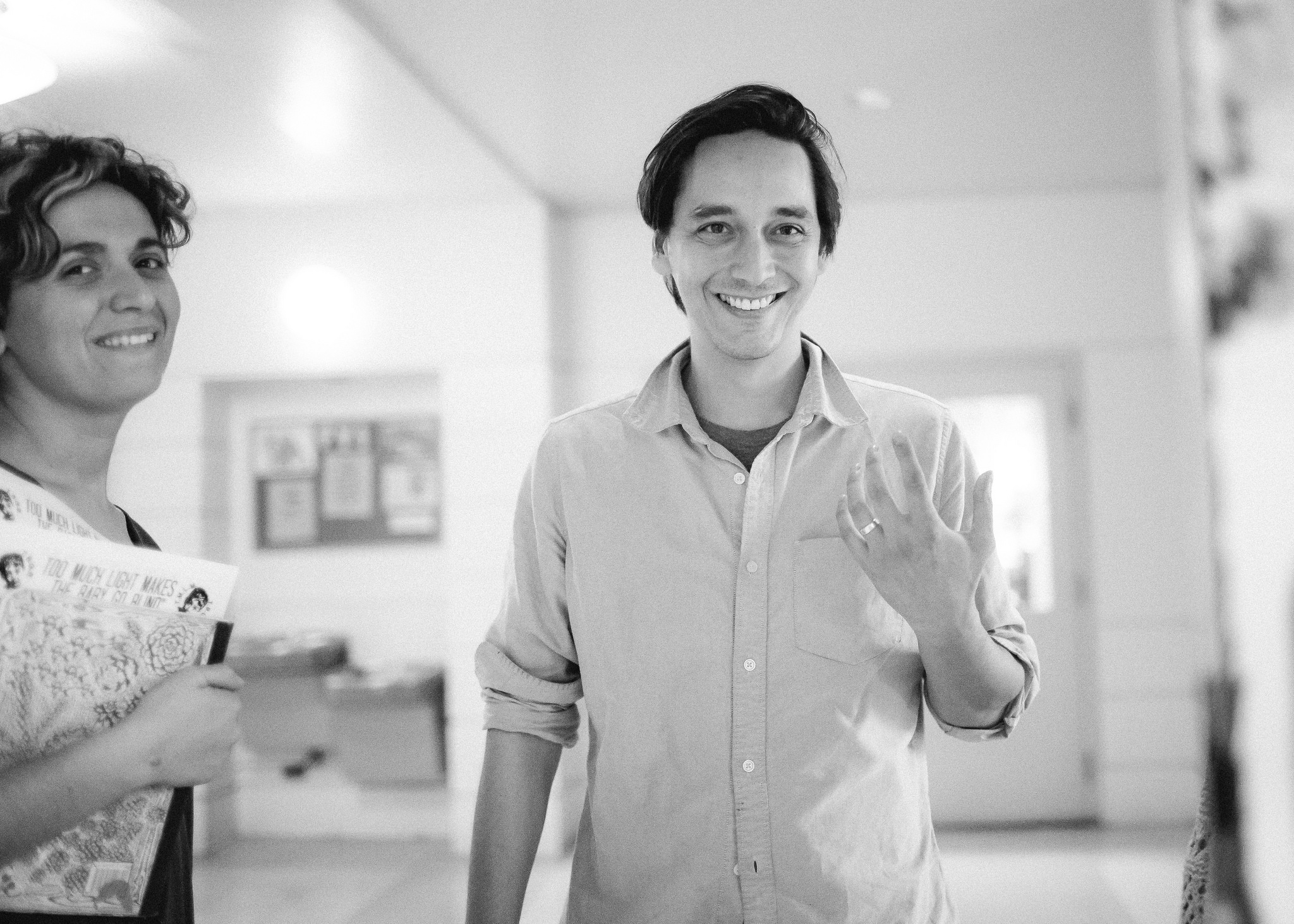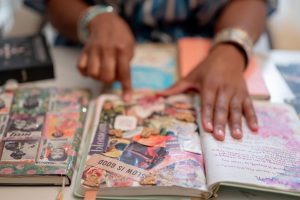Kurt Chiang, artistic director of The Neo-Futurists, calls their space in Andersonville “a labyrinth,” and when you go see their signature show, Too Much Light Makes The Baby Go Blind, entering the building can feel like entering another world.
Your experience begins in a long line of people outside the building. There, you are given a token to reserve your seat.
You enter the building and trek up two flights of stairs. To the left are the bathrooms. To the right is “The Hall of Presidents,” a long hallway lined with portraits of every US president to date, rendered in a variety of artistic styles.
Go down this hallway, and you are in a kitchen. There is a candy counter manned by a volunteer, and behind the volunteer is a sink, some cabinets, a stove. It’s a kitchen.
Past the candy counter, past the antique photo booth, past a typewriter station, through two double doors, and down a step into “The State Park,” a gymnasium-like space with a player piano at one end, and a collage on the wall of old nametags arranged into the shape of a giant pointing monster.
The crowd, once a straight line, spreads like jam across the floor to become a chatting swarm for a brief minute before an ensemble member climbs on top of a platform and orders the swarm back into a line.
At the end of this line you hand in your token (don’t lose it!), roll a six-sided die to determine your ticket price ($9 plus whatever you roll!), and hand them your money (cash only!).
You tell them to keep the change, and they yell, “Keep the change!”
Up a step, down a step, a hop skip and another door later, and someone wearing headphones asks you what your name is. You tell them, and they hand you a nametag with a random phrase written on it.
You push through one last set of double doors, someone gives you a program, and then finally you are in the theater, free to find a seat.
As the audience makes its way into the theater, the ensemble makes its way onto the stage, until both groups are situated. Then the music fades out, and the show begins.
This winding series of hallways and checkpoints, which began as a practical necessity for a theater company without a traditional box office, has since become an expected part of the theatrical experience, and a fitting prologue to a show that is as eclectic as the space in which it is performed. This journey prepares the audience for what they are about to see, but for some theatergoers, it makes physically getting to the show a challenge or else completely impossible.
A few weeks ago I sat down with the artistic director, Kurt Chiang, and Education Coordinator, Lily Moony, to talk about accessibly in theater and their new Neo-Access program.
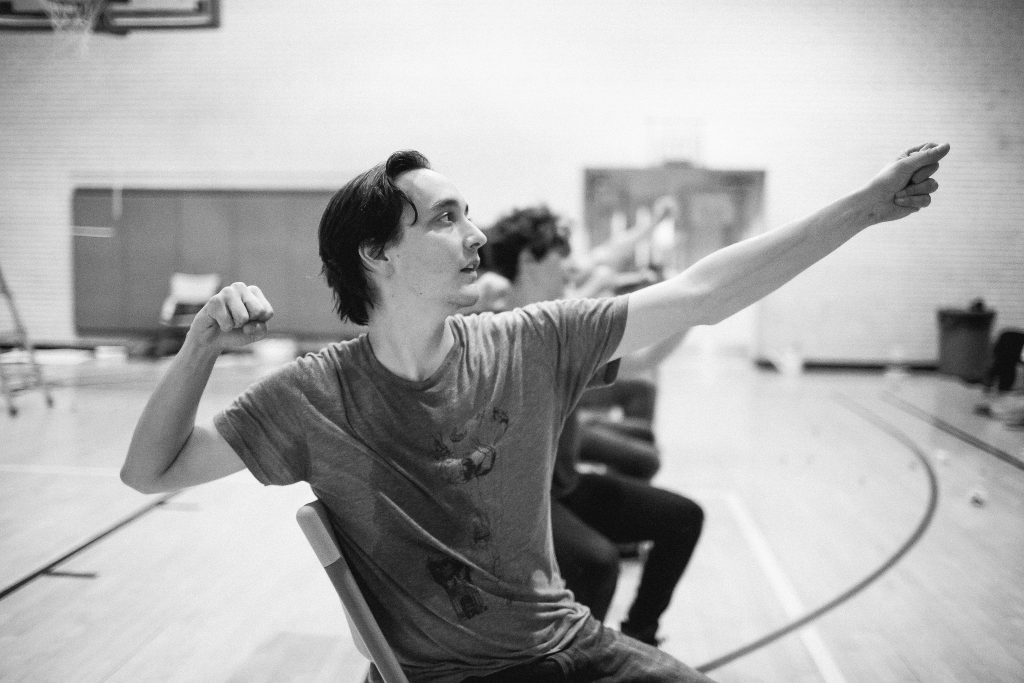
Hal Baum: Kurt, can we get a quick description of Too Much Light Makes The Baby Go Blind for those who might not be familiar with the show?
Kurt Chiang: Too Much Light is essentially 30 plays performed in 60 minutes. You see a clothesline with 30 pieces of paper that have numbers printed on them, and these numbers correspond to play titles that you have on your program. Between plays the audience shouts the number of the play that they want to see next, in order to determine the order.
The overarching aesthetic or tone… If there is a theater that makes Shakespeare plays, we make Neo-Futurist plays, and what that means is that they come from a place of personal narrative and honesty. We don’t play characters, we write from our own experiences, and we acknowledge what is happening in the room in a non-illusory way. There is not a set onstage transporting you to a kingdom in England, or France, or Spain or…
HB: Portugal?
KC: Even Portugal.
HB: Unless one of you went to Portugal.
KC: Right. And then it would be a play about someone’s vacation to Portugal, which would probably be a pretty boring play.
HB: How would you describe your audience?
KC: I like to describe the Neo-Futurist audience as a group of regular people. That is a different thing from a lot of other theaters, which can either be a subscriber base or an audience full of industry professionals. I think a lot of our audience actually doesn’t see other theater because it doesn’t move them or because it is too expensive. It’s an eclectic audience who isn’t necessarily there to be mini-critics of your craft. They are actually trying to key into something that is on stage, because it is speaking to them in the now.
I also describe them as a Chicago audience. This is an art that can immediately serve a city, and the people in that city. As we try to develop our audience, to sustain it, and also grow it, we look at what the neighborhood [Andersonville] is right now, and what our city is right now, and as long as we are able to reflect that, then we are doing our job.
Andersonville is traditionally a… it used to be called “Girlstown,” but now people say that it’s an extension of Boystown, but it’s generally a, umm, a…
HB: A gayborhood? Quote unquote.
KC: [laughter] Yes. It’s a “gayborhood.” We do many pride shows every year, and that’s a strong reflection inside our ensemble. A good majority of the people on stage identify as LGBTQ.
Lily Mooney: The pride shows are a lot of the most fun. They are on pride weekend, so I don’t think that our queer audience is necessarily hurting on that weekend for stuff to do, but I think that the show is a fun, exciting, and variegated experience. Even in the midst of pride weekend you will see stuff that is sad, or full of rage, or not very PC, and all of that can exist together. I think for the queer audience that we pull in, representation on stage is a huge deal. We have a transgender person in the ensemble, I’m talking about Malic White right now, who writes about all kinds of different things, everything, but the experience of being transgender informs a lot of their work, which is really compelling to people.
HB: Could you tell me a little bit about Neo-Access? What it is and how it got started?
LM: It was an idea that was proposed to our ensemble by Taylor Bailey, who is an administrator here. He was inspired by work he had done at other places and saw a real potential at the Neos to do something similar. It was about opening our doors wider and being more inclusive. Reaching out to specific demographics who were not experiencing Neo-Futurism as easily. We found grant funding for it, and were able to put the ideas into practice.
The first wing of Neo-Access was a year of making performances that are physically accessible, and accessible to people who are blind and deaf. They have services, and are done offsite in accessible spaces. The community part of Neo-Access includes our work with Alternatives. And then the third thing is the scholarship program for artists of color.
HB: The accessible shows are at Victory Gardens, right?
LM: Mmm-hmm. We did two shows at Victory Gardens last year, and Victory Gardens, unlike our space, is physically accessible, and they have their own accessible programing that is much more extensive than ours, so through them we were connected to ASL interpreters and an audio describer for blind audience members. They also do touch-tours before the show, for blind audience members.
HB: What does that mean?
LM: You show up about an hour early for the show and you are met by a touch-tour guide who is educated on the ins and outs of the set and the run of the show. The idea is that someone who is coming who has limited sight, or is blind, is going to experience the show in a different way, but the touch tour gives them the opportunity to get up on stage and handle props and objects that are in the show.
There’s a whole world of artistic approaches to making a good accessible show. The way Victory Gardens does it right now, especially with us, was to put all of that in one night. So the shows were curated to accommodate all those things at once (wheelchair access, touch-tours, captioning, and audio descriptions). This year, we are looking at beginning to have a more broken up approach, so that we are going to see what it is to integrate blind accessible services into a regular Too Much Light, and then make a deaf accessible show, and then later take a show offsite that has services and is physically accessible too.
Another thing that happened in that year was that we taught a class, and then that class did an accessible show, and there were four artists in that class who had disabilities. Will Sondheim, our communications manager, said that that show was the point of the Access year. The meaning of having someone in a wheelchair onstage, who uses accessible bathrooms, doing this sarcastic piece about trying to find an accessible bathroom, is an exciting, different story to hear, as opposed to me standing up and narrating for someone else.
HB: What is Alternatives?
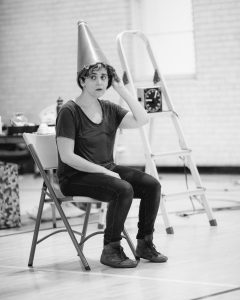
LM: Alternatives is a youth development agency in Uptown, located at Sheridan and Lawrence, and they have a variety of different programing geared towards youth in the city. They serve a lot of students from the South Side and the West Side, and Uptown. They also have a clinical program that serves kids who have experienced trauma of some kind.
The way we have partnered with them is through a specific program called “Urban Arts” which is an arts program that happens a few days after school and on the weekends. We are in the second year of that partnership, going and teaching theater to 14 through 18-year-old students that is informed by the Neo-Futurist work we do. And that is a partnership that got set up in the spirit of reaching out into the community.
We have a pretty loyal high school following at our shows, but that is mostly high school students from the suburbs who drive in, or city kids who are local to this area. The young people that Alternatives serve are not the same audience that we get in to see the show. The demographic breakdown, racially, is predominantly Black South-Siders, and also Latino and Latina students from the South and West Side, and then also folks from Uptown.
Now that I have been inside of it, as a teaching artist, I think that we had a simple intention: We’re going to go teach the youth that aren’t coming, and then the youth are going to engage, and then who knows what happens next? Maybe things will just become more diverse! [laughs]
No one thought that out loud to themselves, but I think the initial thought was that we have this curriculum that we are going to go and teach in this program, but actually the reality of doing that well has been a lot more about serving the program, and serving the students, and meeting them exactly where they are.
Also, learning what parts of this aesthetic that we practice might have some implicit privilege inside of it. For example, a young person who has endured a lot of trauma might not be prepared or excited to be in the first person in front of people on stage.
There has been a lot of revising there, and getting better at working with youth. Youth programming in general is a thing we are slowly developing here.
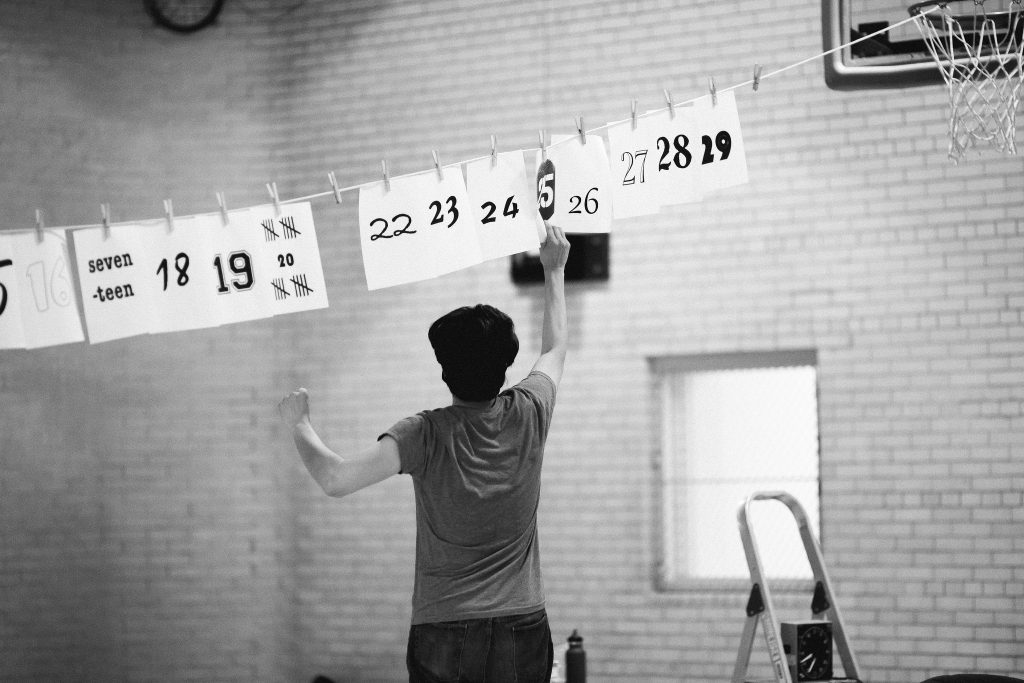
HB: What is the scholarship program that you mentioned?
LM: About every six months now we take applications for people to receive a $300 scholarship to take classes here. It is exclusively for artists of color. That’s not a checkbox thing, we just invite people to apply and then they self identify. From the pilot round we chose six people, and from the last round we chose six people, and hopefully the funding for that can expand because we get great applications, a larger number than we have been able to accommodate.
That was also a thing where the language of putting that idea into the world had to get worked on, and the spirit of it had to get clarified. We’re not trying to assume that a person of color who is applying for the scholarship has a financial need; we are just trying to incentivize under-represented artists and people to come into the building. It’s easier to take a class here if the class is free, so we want people of color to be able to come in and engage at that level right away.
Right now it is up to us, and up to them, to see how that relationship continues.
HB: Do you find that the experimental nature of the show makes it more accessible, or does that make it more challenging?
KC: As far as accessible performance, the services never feel tacked on. The opportunity is rich for [the services] to be integrated into the experience, which is exciting, and it makes us more dexterous with how we are making our art too.
We had one consultant telling us, “Make the show exactly what you would see at the regular show,” and then another consultant told us, “Actually no, let those services effect the show. Use those things, and incorporate them into the show.”
She was a deaf person who talked about going to see plays and being grateful that the captioning was there, but she was like, “What if the captioning was on the bathtub all of a sudden?”
The experience is still a theatrical experience, so if another thing is being introduced it is important to think about how it is being unified with the story that is being told. We have every availability to organize it in a brand new way.
LM: Yes. I would say the experimental quality can make it more accessible at the level of the art itself. The challenge for us is more about putting our resources and time into getting people in the door, like, literally up the stairs, or across the city.
Accessibility has been an artistic mission of the organization since the foundation of the show. The way the show is set up and what it is supposed to do is engage people, but even with the political statement of “We’re not going to suspend disbelief, and it’s going to be way more current, and anyone can get involved and be a part of it,” you don’t overcome the systems that you are a part of, or your location in the city, or the segregated nature of your city, just by saying that. It is way more work, and you have to look at a lot of other pieces. It is incremental work over time.
We hope that you, every individual, you, and all the intersecting factors that make up who you are, should be able to enter the space and engage it uniquely and feel like your experience of it is valid.
Too Much Light Makes The Baby Go Blind runs consistently at The Neo-Futurarium, 5153 N. Ashland Ave., every Friday and Saturday at 11:30 PM and every Sunday at 7:00 PM. Tickets are between $10-15 depending on a random die roll. For ticket information, visit www.neofuturists.org or call 773-878-4557.
For more information about Neo-Access, Alternatives, or Scholarships for artists of color, visit www.neofuturists.org/access
Featured Image: Lily Mooney and Kurt Chiang at Brave Lux at Don Nash Park. Photo Credit, Joe Mazza.
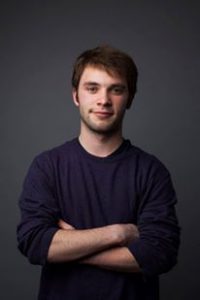
Hal Baum is a writer and performer living in Chicago. His work has been featured in The Arrow at The Neo-Futurists and The LivingRoom at Stage 773. He can be seen at theaters across the city performing with his improv team, 99 Problemz, and in his spare time he interviews friends and strangers on his podcast, “Stuff With Hal Baum.”
For more from Hal, check out:
https://medium.com/@halbaum
